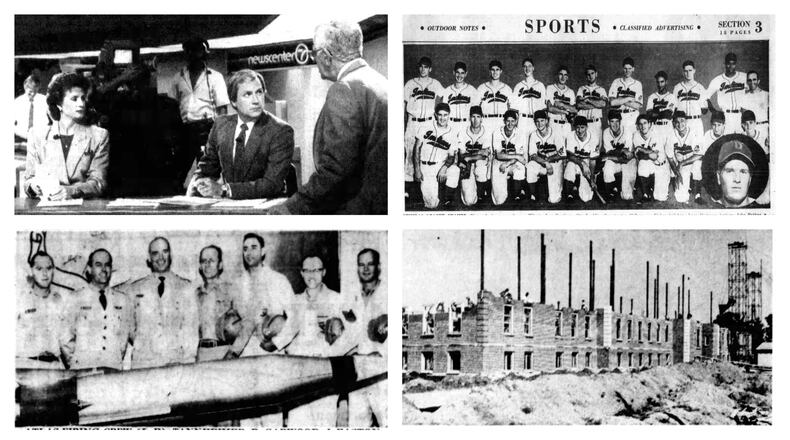Here’s a look at some stories from the week of Sept. 8-14.
Sept. 10, 1939: Dayton State Hospital building rapidly rising
The exterior construction of the new reception building at the Dayton State Hospital had reached the halfway point.
The new structure was being built at a cost of $185,000. It was to house 175 patients in two wings.
The basement had a kitchen, two dining rooms, recreation rooms, 12 clinic rooms and two hydrotherapy baths.
The first floor was designed to have eight single-patient rooms, nine wards, two day rooms, offices for doctors, two nurses stations, two waiting rooms and more.
The second floor was about the same, but with operating rooms and no offices.
The building was expected to be completed by December of that year.
Sept. 11, 1949: Given new park, Dayton might get AAA baseball
In 1949, there was a lot of talk about a realignment of Major League baseball teams. There was even talk about Dayton possibly getting a AAA minor-league team.
The problem was that Dayton didn’t have a good enough stadium.
The Dayton Indians were a single A team for Cleveland. They played at Hudson Field, which was considered “wholly inadequate.” There were bleacher seats instead of comfortable chairs and not enough roofing covering the stands to protect fans from rain.
The Indians, who were in the Central League, were a top contending team for the league title two years in a row but lagged near the bottom in attendance.
Rudie Schaffer, the business manager for the Cleveland Indians, wrote a letter to Dayton Daily News sports writer Si Burick about the matter.
“A new modern stadium is what Dayton needs to forge ahead in the sports world, and the lack of proper facilities is why the Dayton fans have not supported the Dayton Indians as compared to the fans of Charleston, Flint and Muskegon,” he said.
“Dayton fans are good fans and we have tried our best to give them the ‘tops’ in Class A baseball. This we will continue to do, but the rest is up to Dayton.”
Sept. 10, 1959: Parents here proud of Daytonian who guided Atlas in key test
The man who told the nation’s first operational Atlas intercontinental ballistic missile (ICBM) where to go was a former Daytonian who was an Air Force electronics specialist.
Capt. Dewey M. Garwood Jr. was the senior guidance control officer, in charge of the complex electronics that told the missile which way to travel.
The parents of the 1942 graduate of Wilbur Wright High School were proud.
“We’re sure he feels that all of his work has been worthwhile. He has told us that he found his work very interesting,” said his mother.
Garwood went through cadet training shortly after high school, then left to attend the University of Cincinnati. He returned to active duty in 1947.
He had two overseas tours in Japan before being assigned to the aircraft control and warning radar station at Bellefontaine for three years. After that, he spent 14 months with the Strategic Air command in Maine, flying tanker planes.
He was then transferred to Vandenberg Air Force base in California, where he worked with the Atlas missile program.
Sept. 9, 1979: School junk-food ban is ding-dong, kids say
The Dayton Board of Education had just approved a new nutrition policy which eliminated the sale of junk foods in schools, and many students were not happy about it.
The new policy banned soda, chewing gum, candy and even some potato chips.
Wilbur Wright High School had nine vending machines, and students were lining up to get the sugary snacks while they still could.
“I don’t think they should be allowed to ban snacks and sweets,” said senior Lynn Fickert. “I drink pop, too, with my lunch, because I’m allergic to milk. What am I supposed to do now? Drink water?”
“I’m going to miss the candy, because after I eat lunch I develop a real sweet tooth,” said junior Frances Ledford.
Leo A. Lucas, a member of the Board of Education, was worried what students might do.
“I think we are going to set up a procedure that will create bootlegging in the schools during the lunch period,” he said.
Peter Drake, a senior, agreed, saying, “It probably will happen here. You’ll have kids who will bring all sorts of junk foods from home to sell them here and make a profit.”
Sept. 10, 1989: WHIO-TV ready to debut 5:30 newscast
In 1989, WHIO-TV was about to expand its nightly news programs to 90 minutes.
Viewers were to see co-anchors Ken Jefferson and Cheryl McHenry reporting the top stories of the day, and Ted Ryan was the weatherman. John Condit and James Jordan were to share sports duties.
Channel 7 was the second local network to go to a 5:30 newscast, the first being WDTN-TV (Channel 2), which had being doing it for five years.
News Director Skip Hapner said audience research fueled the decision to add the half hour.
“Our studies showed people wanted to know what was going on in the world and in their community and that they wanted to know about it as soon as they got home from work in the evening,” he said.
The 5:30 show was to replace Cosby Show re-runs.
About the Author






